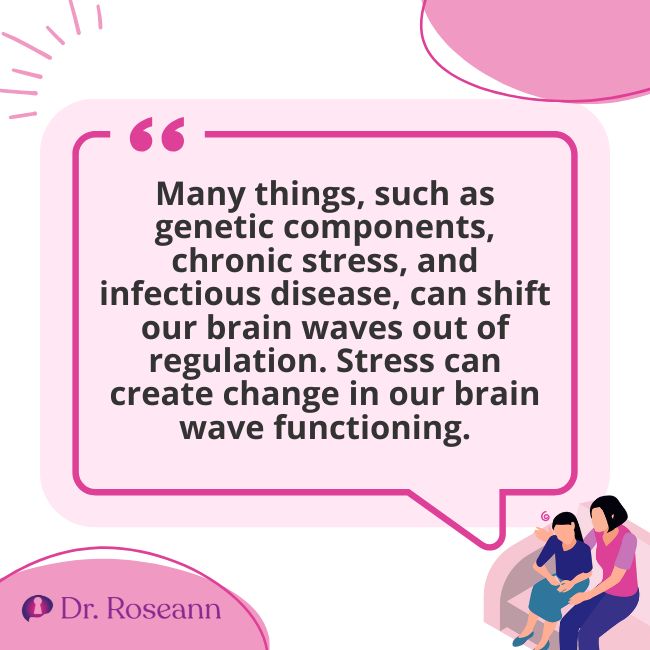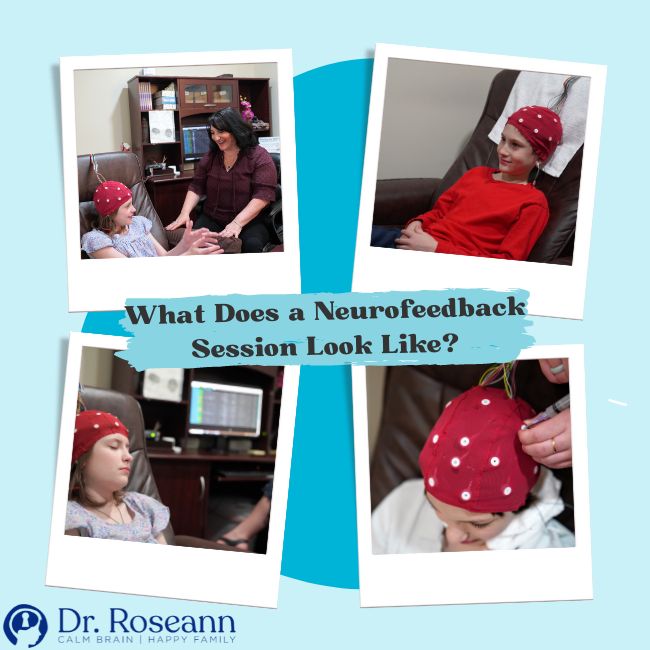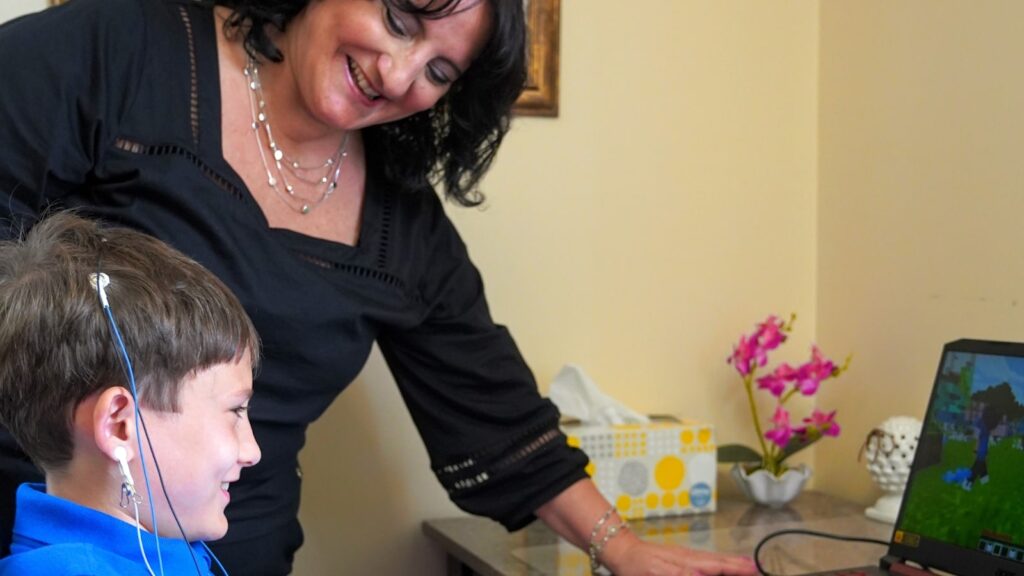Through technology, neurofeedback training reinforces and teaches the brain how to self-regulate so a person can focus, be calm, and learn. Without regulating the nervous system, a person can’t pay attention, learn, or take action effectively or optimally.
Neurofeedback safely and effectively creates lasting change in the brain over time as it learns to rewire brainwave activity and get into a calm, focused parasympathetic state, and this is what we want for our kids.
Every parent wants their child to have a healthy brain and body so that they can continually feel good and confident in themselves. Children can’t succeed academically or socially when they don’t have self-confidence, which is hard to obtain when their brains and behavior are dysregulated.
Can Neurofeedback Treatment Help Improve Attention and Executive Functioning?
Neurofeedback is an effective treatment for kids with ADHD, backed by solid research. Various studies have shown its success in reducing ADHD symptoms by over 90%. The American Academy of Pediatrics even rates it at Level 1 effectiveness, which is on par with medication for treating ADHD (Lofthouse et al., 2011).
In-depth research, like meta-analyses, indicates that after undergoing neurofeedback, kids experience significant improvements in reducing inattention and impulsivity. It also shows promising results in managing hyperactivity.
A study by Van Doren et al. (2018) examined how neurofeedback treatment helps kids with ADHD over time and found out that it can reduce symptoms like pharmaceutical ADHD medicine does. It's a viable non-stimulant option for ADHD.
Sasha was a straight-A student but always struggled with executive functioning and focus, to the point where her mom always had to remind her about deadlines. It started to break down their relationship, and the two were always bickering, ending up frustrated.
Eventually, despite getting great grades, Sasha started to feel “stupid” because she could never get her work in without nagging. Her lack of confidence started holding her back socially, and her parents began seeing low self-esteem during college applications.
Sasha would only apply to “safe schools” because she felt so negative about herself. That is when her parents decided to start neurofeedback and use my BrainBehaviorReset™ Program virtually through our center. Sasha learned how to regulate her brain to be more focused and organized, and then we paired it with new learning strategies to change her behavior.
Remember, you can’t make someone more focused without addressing their behavior! They need to calm down that nervous system and then learn new behaviors to rewire the brain and behavior. Once she was managing her work, her confidence soared!
What is Neurofeedback?
Neurofeedback is a safe, natural, and highly effective way to regulate the nervous system and directly impact how our brain waves function. We all have the same brain waves, but they change depending on what we are using them for.
It’s a powerful technique that involves reinforcing specific brainwave activity to change electrical activity and neurotransmitter function. Remarkably, it even impacts brain activation and structures, revealing white and gray matter alterations.
For example, we are often in a Delta state when we sleep. We may be in an Alpha state if we are relaxed or chilled out. Beta waves are important waves because they are tied to focus. Our brain waves can become low in certain areas or excessive in others.
That is when dysregulated behaviors show up; problems with focus, irritation or moodiness, learning issues, difficulty following directions, behavioral issues, and so on. Most behavior results from dysregulation of the nervous system, and the good news is we can regulate the brain and behavior by regulating brain waves with neurofeedback.
It is important to realize that many things, such as genetic components, chronic stress, and infectious disease, can shift our brain waves out of w hack. Even stress in our daily lives can create change in our brain wave functioning.

We have been falsely led to believe that all behavioral, attentional, or mood problems are caused by a neurotransmitter problem when these issues are much more likely to be caused or exacerbated by long-term stress, inflammation, toxins, and infectious disease. In today's stressful world, even the happiest of kids can be affected by chronic stress.
Neurofeedback helps to regulate the central nervous system and change how our brain waves function, which helps improve symptoms related to different mental health symptoms and clinical disorders such as executive functioning and attentional problems, OCD, PANS/PANDAS, and anxiety. You may wonder, “What happens when my child starts neurofeedback?” Let’s discuss.
How Do You Start Neurofeedback?
When preparing someone for neurofeedback, we start with a QEEG brain map. This allows us to see what kind of brainwave activity is going on in certain brain regions and takes the guesswork out of understanding what is causing the behaviors you are seeing. Instead of wondering, “Is this ADHD?” or “Why is my child acting like this?” the results of a QEEG or a brain check let us get to the bottom of what is happening.
Neurofeedback, a treatment method based on operant conditioning, involves providing the brain with visual and auditory reinforcement. It helps the brain learn to self-regulate and find a healthy rhythm. Computer technology plays a vital role in this process by delivering real-time, pleasing reinforcement to the brain while measuring brain wave activity.
With a QEEG, you can see brain wave activity over the structure. For example, you can see what the frontal lobes, our executive functioning and attention job manager, or the limbic system, your emotional center, are doing rather than guessing.
You can also see the interconnections between the brain sites, which allows you to see what is happening between the left and right regions of the brain. This is where a lot of communication takes place, which helps our kids learn, be alert, and take action. These are all things with which many kids today are struggling.
A QEEG tells us where the brain is underperforming or where the brainwave activity may be hyperactive. That interactivity is often related to poor attention, slow processing, or withdrawn behaviors, and over-activity is related to anxious, obsessive, moody, or irritated behaviors.

A QEEG or brain check provides us a path to which areas of the brain we want to train to improve focus, calm, and processing. So, after the brain check or QEEG, we give you my trademarked BrainBehaviorReset™ Program protocol unique to each client and each client’s brain functioning.
For those that come to our center, we perform a QEEG brain map, in which you are hooked up to sensors, and the brainwave activity is recorded. If you are working with us remotely, we do a brain check by taking statistical averages that guide us to which areas to train your brain for remote, home-based neurofeedback. You can learn more about in-person and virtual training here or by contacting our center.
What Does a Neurofeedback Session Look Like?

You may have heard of neurofeedback, but, like most, you have no idea what a neurofeedback session looks like or how it works. With neurofeedback, a person’s subconscious receives reinforcement every time they produce a healthy combination of brainwaves, which rewires the brain and central nervous system.
The good news is that the subconscious does the work. Within two to three seconds from the moment you begin neurofeedback training, the brain wants the subconscious auditory and visual reinforcement it receives.
Hence, it instantly produces a healthy, regulated response. It needs time to “learn” and adapt to this new healthy response, so most people are doing forty or more sessions to train the brain to regulate consistently, which means a child or person is more focused, calmer, and can learn more efficiently.
Neurofeedback, a technique used in various healthcare fields, including physical therapy and occupational therapy, may be operated by LVNs, LPNs, and board-certified neurofeedback practitioners. Depending on the machine used, it requires sensors on the head, commonly known as a 10-20 sensor placement which ensures consistency and uniformity for all neurofeedback practitioners.
During our in-person or virtual neurofeedback sessions, you will watch a movie, and your neurofeedback technician, or you at home, will place the sensor on the area of your brain that is being trained.
Your subconscious brain must produce a healthy combination of waves to receive visual and auditory feedback, such as the movie playing. Your brain desperately wants this “feedback” and will change itself to get the move to play, which resets your brain waves and the nervous system.
In other words, the movie will not play properly until your brain produces this healthy combination. Neurofeedback is based on operant conditioning, which means your brain is learning how to regulate itself based on the positive feedback it receives from the neurofeedback training equipment. When your brain learns to get into a healthy rhythm to create more healthy brain functioning, you see positive differences in behavior.
Neurofeedback involves consistency, and it cannot be “fixed” overnight. Like working out a muscle, your muscle can’t grow bigger overnight, and one has to do two to three sessions a week over time for the brain to learn and sustain the changes. Over a series of sessions, normally no less than twenty, negative symptoms and behaviors begin to decline, and changes in stress levels, behavior, and attention occur.
Does my Child Need Neurofeedback?
Every child can benefit from neurofeedback, especially those with attentional, learning, and behavioral symptoms that interfere with their ability to learn, focus, and interact with others. Neurofeedback is used for various conditions, and I use it for everything from ADHD, anxiety, PANS/PANDAS, OCD, and many other conditions.
Neurofeedback is safe, effective, and can create lasting change in behaviors and learning, and all parents should consider neurofeedback as a research-tested and much safer alternative to medication.

Are All Neurofeedback the Same?
No, not all neurofeedback is the same! People worldwide seek me to help their “treatment failures” children when medication and talk therapy have not provided lasting relief. Neurofeedback is an integral part of my trademarked BrainBehaviorReset™ Program.
It is highly dependent on the experience and quality of care you receive from your neurofeedback provider, which is why so many people seek care from me and our trademarked process.
Using a board-certified neurofeedback practitioner ensures that your provider has met certain qualifications. You can learn more about board-certified practitioners from the Biofeedback Certification International Alliance (BCIA). These neurofeedback practitioners have the BCIA blueprint of knowledge to help kids with various mental health conditions.
Central to our BrainBehaviorReset™ Program is using neuroscience to achieve symptom reduction. Healing and symptom reduction cannot happen if our bodies and nervous system are in a stress hyper-activated state. Neurofeedback regulates the nervous system and changes the function of the brain.
Neurofeedback helps the brain work, so almost everyone gets a sense of calm and increased focus to learn a different way to respond, learn, or respond in their environment. Once the nervous system is reset with neurofeedback, kids can experience better grades, greater self-confidence, improved sleep and mood, and better communication skills.
How Long Does Neurofeedback Last?
A lot of parents wonder if neurofeedback produces lasting change. Well, research shows it produces structural changes in the brain (Ghaziri et al., 2013) and that months and years later, behavioral change and symptom improvement are lasting (Van Doren et al., 2018).
From my three decades of work and as I discuss in my book, It’s Gonna Be OK!, I can tell you that incorporating lifestyle changes such as healthier eating, learning stress management skills, and unlearning maladaptive behaviors enhances neurofeedback and deepens the change.
It is what we teach in our trademarked BrainBehaviorReset™ Method and why people worldwide chose the best care possible from the recognized leader in children’s mental health, Dr. Roseann, for their children and themselves. With neurofeedback, their brain is not only stabilized, but the health of their nervous system improves, and symptoms decrease so they can feel confident, focused, and calm.
We want our kids to have healthy brains and bodies so that they can not only feel good today, but they can continue to feel good in their future endeavors, and neurofeedback is an incredible way to improve their mental health. To learn more about neurofeedback, check out my Youtube video on How Neurofeedback Can Help Your Child.
Parent Action Steps
☐ Learn about neurofeedback training and its potential benefits
☐ Seek qualified, board-certified neurofeedback practitioners and discuss treatment
☐ Understand the process for effective neurofeedback training.
☐ Have realistic expectations and be consistent with sessions.
☐ Ask questions and get a QEEG brain map for insights.
☐ Monitor your child's progress during and after neurofeedback sessions.
☐ Support healthy lifestyle changes alongside neurofeedback.
☐ Take our Solution Matcher to get personalized treatment for your child.
Citations
Ghaziri, J., Tucholka, A., Larue, V., Blanchette-Sylvestre, M., Reyburn, G., Gilbert, G., Lévesque, J., & Beauregard, M. (2013). Neurofeedback Training Induces Changes in White and Gray Matter. Clinical EEG and Neuroscience, 44(4), 265–272. https://doi.org/10.1177/1550059413476031
Lofthouse, N., Arnold, L. E., Hersch, S., Hurt, E., & DeBeus, R. (2011). A Review of Neurofeedback Treatment for Pediatric ADHD. Journal of Attention Disorders, 16(5), 351–372. https://doi.org/10.1177/1087054711427530
Van Doren, J., Arns, M., Heinrich, H., Vollebregt, M. A., Strehl, U., & K. Loo, S. (2018). Sustained effects of neurofeedback in ADHD: a systematic review and meta-analysis. European Child & Adolescent Psychiatry, 28(3), 293–305. https://doi.org/10.1007/s00787-018-1121-
Always remember… “Calm Brain, Happy Family™”
Disclaimer: This article is not intended to give health advice and it is recommended to consult with a physician before beginning any new wellness regime. *The effectiveness of diagnosis and treatment vary by patient and condition. Dr. Roseann Capanna-Hodge, LLC does not guarantee certain results.
Are you looking for SOLUTIONS for your struggling child or teen?
Dr. Roseann and her team are all about science-backed solutions, so you are in the right place!
Discover the three Natural Solutions for ADHD, Anxiety, and Mood
Empower yourself with natural solutions for your child's mental health and behavior. Download our FREE quick start guide and start supporting your child today.
You can get her books for parents and professionals, including: It’s Gonna Be OK™: Proven Ways to Improve Your Child’s Mental Health, Teletherapy Toolkit™ and Brain Under Attack: A Resource For Parents and Caregivers of Children With PANS, PANDAS, and Autoimmune Encephalopathy.
If you are a business or organization that needs proactive guidance to support employee mental health or an organization looking for a brand representative, check out Dr. Roseann’s professional speaking page to see how we can work together.
Dr. Roseann is a Children’s Mental Health Expert and Therapist who has been featured in/on hundreds of media outlets including, CBS, NBC, FOX News, PIX11 NYC, The New York Times, The Washington Post, Business Insider, USA Today, CNET, Marth Stewart, and PARENTS. FORBES called her, “A thought leader in children’s mental health.”

She is the founder and director of The Global Institute of Children’s Mental Health and Dr. Roseann Capanna-Hodge, LLC. Dr. Roseann is a Board Certified Neurofeedback (BCN) Practitioner, a Board Member of the Northeast Region Biofeedback Society (NRBS), Certified Integrative Mental Health Professional (CIMHP) and an Amen Clinic Certified Brain Health Coach. She is also a member of The International Lyme Disease and Associated Disease Society (ILADS), The American Psychological Association (APA), Anxiety and Depression Association of America (ADAA) National Association of School Psychologists (NASP), International OCD Foundation (IOCDF) International Society for Neurofeedback and Research (ISNR) and The Association of Applied Psychophysiology and Biofeedback (AAPB).
© Roseann-Capanna-Hodge, LLC 2023










